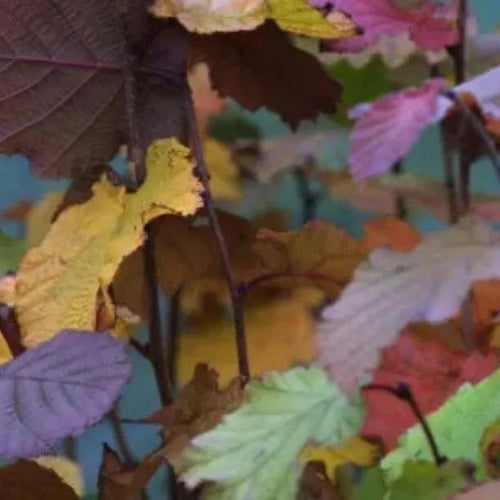Purple-Leaved Filbert Hazel Hedging
Purple Hazel, Corylus maxima Purpurea, is a variety of Filbert Hazel with superbly rich purple leaves, grown for its ornamental value in borders and garden hedges, rather than for farm or wildlife hedges, where Common hazel is best.
It's very hardy, suitable for any soil, and quite shade-tolerant, making it one alternative to Copper Beech (which needs sun and well drained soil).
Purple Hazel is a good a specimen tree, with long pink catkins in early spring that attract bees, followed by dark plum-purple foliage that turns into a jumble of different colours in autumn.
Note that this Corylus maxima Purpurea hedging is not the cultivar 'Red Filbert', but you will see it called Purple or Red (Leaf) Filbert around the place.
Purple leaf hazelnuts are edible like any other, but smaller than Cosford Cob, our recommended variety for nut harvesting.
It can reach about 8-10 metres.
Features
- Any moist soil.
- Great purple leaves, good alternative to Copper Beech
- Jumbled Autumn colour
- Vigorous, bushy tree
- Nuts inferior to other Hazels
- Not as shade-tolerant as Common Hazel
- Can be used as country hedging (but not native)
- Max. Height: 10m
- Bareroot Delivery Only: Nov-March
All our sapling trees are measured by their height in centimetres above the ground (the roots or pots aren't measured).
Browse our full range of nut trees or see the full variety of fruit trees.
Spacing a Purple Hazel hedge:
- For a normal garden boundary hedge, plant at 3 plants per metre (every 33cm) in a single row. For security, mix in thorny plants such as wild roses and Hawthorn for a native wildlife hedge, or purple leaf berberis to match colours.
- A stock-proof country hedge requires 2 staggered single rows (i.e. start one row 16.5cm after the other), with 40cm between rows. That works out at 6 plants per metre in total.
- An interior, decorative garden hedge for can be planted at 2 plants per metre (every 50cm) in a single row.

 Secure, One-Tap Checkout
Secure, One-Tap Checkout
 Hand Picked, Delivered to Your Door!
Hand Picked, Delivered to Your Door! 1 Year Bareroot Guarantee
1 Year Bareroot Guarantee






